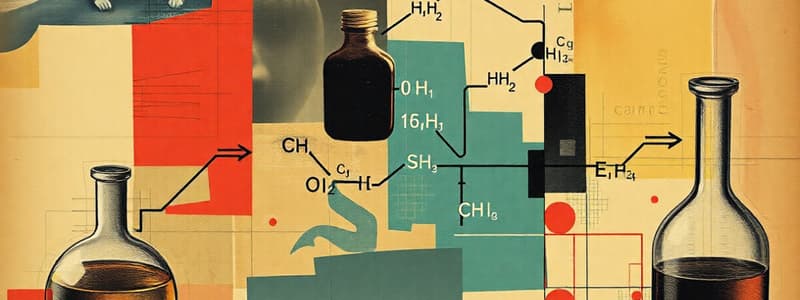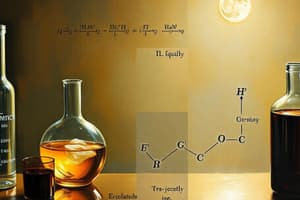Podcast
Questions and Answers
Which of the following best describes the role of coefficients in a balanced chemical equation?
Which of the following best describes the role of coefficients in a balanced chemical equation?
- They provide the relative number of moles of reactants and products involved in the reaction. (correct)
- They indicate the electric charge of each atom in the reaction.
- They specify the physical state of each reactant and product.
- They represent the number of atoms in a molecule.
In a chemical reaction, a substance is said to be reduced when it:
In a chemical reaction, a substance is said to be reduced when it:
- Reacts with oxygen
- Breaks down into simpler substances
- Gains electrons (correct)
- Loses electrons
Which type of chemical reaction is represented by the general equation: $A + B \rightarrow AB$?
Which type of chemical reaction is represented by the general equation: $A + B \rightarrow AB$?
- Displacement reaction
- Decomposition reaction
- Combination reaction (correct)
- Double-displacement reaction
Why is it essential to balance chemical equations?
Why is it essential to balance chemical equations?
In the reaction $Zn(s) + CuSO_4(aq) \rightarrow ZnSO_4(aq) + Cu(s)$, which element is being displaced?
In the reaction $Zn(s) + CuSO_4(aq) \rightarrow ZnSO_4(aq) + Cu(s)$, which element is being displaced?
Which of the following best describes a double-displacement reaction?
Which of the following best describes a double-displacement reaction?
What is the role of an oxidizing agent in a redox reaction?
What is the role of an oxidizing agent in a redox reaction?
Which of the following conditions is typically required for the rusting of iron?
Which of the following conditions is typically required for the rusting of iron?
What is the primary cause of rancidity in fats and oils?
What is the primary cause of rancidity in fats and oils?
How does increasing the temperature generally affect the rate of a chemical reaction?
How does increasing the temperature generally affect the rate of a chemical reaction?
What is the function of a catalyst in a chemical reaction?
What is the function of a catalyst in a chemical reaction?
Consider the unbalanced equation: $CH_4 + O_2 \rightarrow CO_2 + H_2O$. When properly balanced, what is the coefficient for oxygen ($O_2$)?
Consider the unbalanced equation: $CH_4 + O_2 \rightarrow CO_2 + H_2O$. When properly balanced, what is the coefficient for oxygen ($O_2$)?
Which of the following reactions is an example of a decomposition reaction?
Which of the following reactions is an example of a decomposition reaction?
In the redox reaction $2Na(s) + Cl_2(g) \rightarrow 2NaCl(s)$, which substance is the reducing agent?
In the redox reaction $2Na(s) + Cl_2(g) \rightarrow 2NaCl(s)$, which substance is the reducing agent?
Which of the following methods can be used to prevent or slow down rancidity in food products?
Which of the following methods can be used to prevent or slow down rancidity in food products?
Which factor does NOT typically influence the rate of a chemical reaction?
Which factor does NOT typically influence the rate of a chemical reaction?
Enzymes are biological catalysts that:
Enzymes are biological catalysts that:
Which of the following equations represents a redox reaction?
Which of the following equations represents a redox reaction?
In the reaction $AgNO_3(aq) + NaCl(aq) \rightarrow AgCl(s) + NaNO_3(aq)$, what type of reaction is it classified as?
In the reaction $AgNO_3(aq) + NaCl(aq) \rightarrow AgCl(s) + NaNO_3(aq)$, what type of reaction is it classified as?
How does an increase in the surface area of a solid reactant typically affect the rate of a chemical reaction?
How does an increase in the surface area of a solid reactant typically affect the rate of a chemical reaction?
Flashcards
Chemistry
Chemistry
The study of matter, its properties, and how it changes.
Chemical Reaction
Chemical Reaction
A process involving the rearrangement of atoms and molecules to form new substances.
Chemical Equation
Chemical Equation
Symbolic representation of a chemical reaction using formulas and symbols.
Reactants
Reactants
Signup and view all the flashcards
Products
Products
Signup and view all the flashcards
Balancing Chemical Equations
Balancing Chemical Equations
Signup and view all the flashcards
Law of Conservation of Mass
Law of Conservation of Mass
Signup and view all the flashcards
Combination Reaction
Combination Reaction
Signup and view all the flashcards
Decomposition Reaction
Decomposition Reaction
Signup and view all the flashcards
Displacement Reaction
Displacement Reaction
Signup and view all the flashcards
Double-Displacement Reaction
Double-Displacement Reaction
Signup and view all the flashcards
Redox Reaction
Redox Reaction
Signup and view all the flashcards
Oxidation
Oxidation
Signup and view all the flashcards
Reduction
Reduction
Signup and view all the flashcards
Corrosion
Corrosion
Signup and view all the flashcards
Rancidity
Rancidity
Signup and view all the flashcards
Catalysts
Catalysts
Signup and view all the flashcards
Temperature effect on Reaction Rates
Temperature effect on Reaction Rates
Signup and view all the flashcards
Concentration effect on Reaction Rates
Concentration effect on Reaction Rates
Signup and view all the flashcards
Surface Area effect on Reaction Rates
Surface Area effect on Reaction Rates
Signup and view all the flashcards
Study Notes
- Chemistry is the study of matter and its properties as well as how matter changes.
- A chemical reaction is a process that involves rearrangement of atoms and molecules to form new substances.
- Chemical reactions are represented by chemical equations.
- A chemical equation is a symbolic representation of a chemical reaction using chemical formulas and symbols.
Chemical Equations
- A chemical equation includes reactants, products, and an arrow indicating the direction of the reaction.
- Reactants are the substances that participate in a chemical reaction and are written on the left side of the arrow.
- Products are the substances formed as a result of a chemical reaction and are written on the right side of the arrow.
- The arrow (→) indicates the direction of the reaction, pointing from reactants to products.
- Plus signs (+) are used to separate multiple reactants or products.
- State symbols indicate the physical state of substances: (s) for solid, (l) for liquid, (g) for gas, and (aq) for aqueous (dissolved in water).
Balancing Chemical Equations
- Balancing a chemical equation involves adjusting the coefficients of the reactants and products to ensure the number of atoms of each element is the same on both sides of the equation.
- The law of conservation of mass states that matter cannot be created or destroyed in a chemical reaction, hence the need for balancing.
- Only coefficients should be changed when balancing equations, not subscripts in chemical formulas.
- Balancing typically starts with the most complex molecule and proceeds element by element.
- Fractional coefficients can be used temporarily, but the final equation should have whole number coefficients.
Types of Chemical Reactions
- Combination reaction: Two or more substances combine to form a single product.
- Decomposition reaction: A single substance breaks down into two or more simpler substances.
- Displacement reaction: An element reacts with a compound, displacing another element from it.
- Double-displacement reaction: Two compounds react by exchanging ions to form two new compounds.
- Redox reaction: Involves both reduction and oxidation processes.
Combination Reactions
- Also known as synthesis reactions.
- Example: 2Mg(s) + O2(g) → 2MgO(s), where magnesium combines with oxygen to form magnesium oxide.
- Typically exothermic, releasing heat.
Decomposition Reactions
- Often require energy in the form of heat, light, or electricity to proceed.
- Example: CaCO3(s) → CaO(s) + CO2(g), where calcium carbonate decomposes into calcium oxide and carbon dioxide upon heating.
Displacement Reactions
- Involve a more reactive element displacing a less reactive element from its compound.
- Can be single displacement or double displacement.
- Example: Zn(s) + CuSO4(aq) → ZnSO4(aq) + Cu(s), where zinc displaces copper from copper sulfate.
Double-Displacement Reactions
- Involve the exchange of ions between two reacting compounds.
- Often result in the formation of a precipitate, gas, or water.
- Also known as metathesis reactions.
- Example: AgNO3(aq) + NaCl(aq) → AgCl(s) + NaNO3(aq), where silver nitrate reacts with sodium chloride to form silver chloride precipitate and sodium nitrate.
Redox Reactions
- Involve the transfer of electrons between reactants.
- Oxidation is the loss of electrons.
- Reduction is the gain of electrons.
- The substance that loses electrons is oxidized and acts as a reducing agent.
- The substance that gains electrons is reduced and acts as an oxidizing agent.
- Example: 2Na(s) + Cl2(g) → 2NaCl(s), where sodium is oxidized and chlorine is reduced.
Oxidation and Reduction
- Oxidation is the process where a substance loses electrons.
- Reduction is the process where a substance gains electrons.
- Oxidation and reduction always occur together, hence the term redox reaction.
- Oxidizing agents help in oxidation by accepting electrons.
- Reducing agents help in reduction by donating electrons.
Corrosion
- Corrosion is the process by which a metal is degraded due to chemical reactions with its environment.
- Rusting of iron is a common example of corrosion.
- Requires the presence of oxygen and water.
- Can be prevented by coating the metal surface with paint, oil, or another metal (galvanization).
Rancidity
- Rancidity is the oxidation of fats and oils in food, resulting in unpleasant taste and odor.
- Caused by exposure to air, light, or moisture.
- Can be slowed down by storing food in airtight containers, refrigeration, or adding antioxidants.
Factors Influencing Reaction Rates
- Temperature: Reaction rates generally increase with increasing temperature.
- Concentration: Higher concentrations of reactants usually lead to faster reaction rates.
- Surface Area: Increased surface area of solid reactants can increase reaction rate.
- Catalysts: Substances that speed up a reaction without being consumed in the process.
Catalysts
- Catalysts provide an alternative reaction pathway with a lower activation energy.
- They remain chemically unchanged at the end of the reaction.
- Can be homogeneous (in the same phase as reactants) or heterogeneous (in a different phase).
- Enzymes are biological catalysts.
Studying That Suits You
Use AI to generate personalized quizzes and flashcards to suit your learning preferences.




